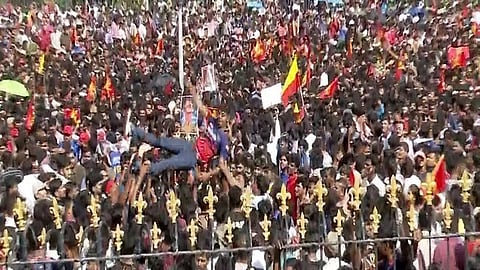

The horrific stampede during the Royal Challengers Bengaluru’s (RCB) IPL 2025 victory celebrations that claimed the lives of 11 youngsters exposed the total failure of the state administration. The powers that be failed to assess the situation and act promptly on it, crucial coordination was missing, and the overseeing mechanism went kaput. Caught in a tailspin, the State Government has taken several damage-control measures to salvage its image.
The opposition is stepping up pressure on the government to act against those responsible for the June 4 tragedy at the Chinnaswamy Stadium, and the High Court is also hearing a PIL. Now, at a time when the government is under intense public scrutiny over the stampede, it has taken a major decision to conduct a new caste census. It seeks to dump the contentious Socio-Economic Educational Survey 2015 (SES-2015), also known as the caste census report, and commission a fresh study.
Although the caste census was a long-standing issue, the timing, and manner in which the developments unfolded raise several questions: Was it in the offing even before June 4? Was it timed to deflect attention from the stampede? Why did Chief Minister Siddaramaiah, who was defending the SES-2015 despite opposition from the dominant Vokkaliga and Lingayat communities and pushback from many of his ministers, suddenly change his stand?
The decision to go for a fresh survey was taken during the CM and Deputy Chief Minister DK Shivakumar’s meeting with party central leaders in New Delhi on June 10. Two days later, it was ratified in the state cabinet.
Sources privy to the developments say that till his meeting with the central leaders, the CM was keen on accepting the 2015 report in the special cabinet meeting on June 12. That was said to have been opposed by Shivakumar. Two days before the special cabinet, both were summoned to the national capital to discuss the stampede and the caste census report.
A day before the cabinet formally decided on the caste census, the CM reiterated that the call was taken by the party high command. “It was not my decision, it was not the decision of the cabinet, it was not the decision of our government. It is a decision of the high command,” Siddaramaiah told reporters. However, after the cabinet meeting, the CM defended the decision to go for a new survey by citing Section 11 of the 1995 Backward Classes Act.
If that was the case, how did a legal provision, which rendered a report, prepared by spending over Rs 165 crore, redundant go unnoticed all these years? That is not clear. Rejecting a report for its findings is one thing but letting it become redundant due to authorities’ inaction is another!
In any case, it is a major relief for Congress as the data from the 2015 SES could have put the party on a collision course with the dominant communities, Lingayats and Vokkaligas. However, the sudden change in the party’s stand is seen as a temporary setback for Siddaramaiah. He had commissioned the 2015 survey during his first tenure as CM, from 2013-18.
Now, as the government prepares for a fresh survey it should ensure that all communities are taken into confidence about its intent and process. It should not descend into yet another tool for politics or create social fissures on caste lines.
While the politics over the caste census will go on, the State Government should not dodge its responsibility to do justice to victims of the stampede. It must introspect on the tragedy that exposed the shortcomings in the system. By the government’s admission, the police failed; the CM was not informed for over two hours after the tragedy, and the event at the stadium was illegal as no formal permission was obtained.
But, merely blaming the Bengaluru police and pointing fingers at others does not absolve the government of its responsibility. It also points to the failure of the overseeing mechanism of the state administration. If there was no permission for the event at the stadium, why did the DyCM participate in it? Why cricket fans were invited to be part of the celebrations there?
Now, over 10 days after the stampede, the blame game continues. The BJP-JDS are blaming the political leadership, and the government faults the organisers. Congress is citing similar tragedies in other states to respond to opposition demands for CM’s resignation.
It is better to keep politics aside and make earnest efforts to ensure that accountability is fixed and that the victims’ families get justice. As the government gets busy with the caste census and the politics surrounding it, it should not lose sight of those who lost their dear ones, many of them ardent fans who rushed to the stadium to be part of the celebrations of RCB winning the trophy after 18 long years. They trusted the state to have taken adequate measures for their safety.
If those responsible for the stampede are not held accountable, if this concludes as yet another episode of political slugfest and buck-passing, it will bring disrepute to the state. Further, citizens will lose faith not just in the government, but in systems of governance and administration.